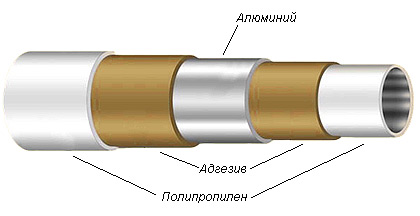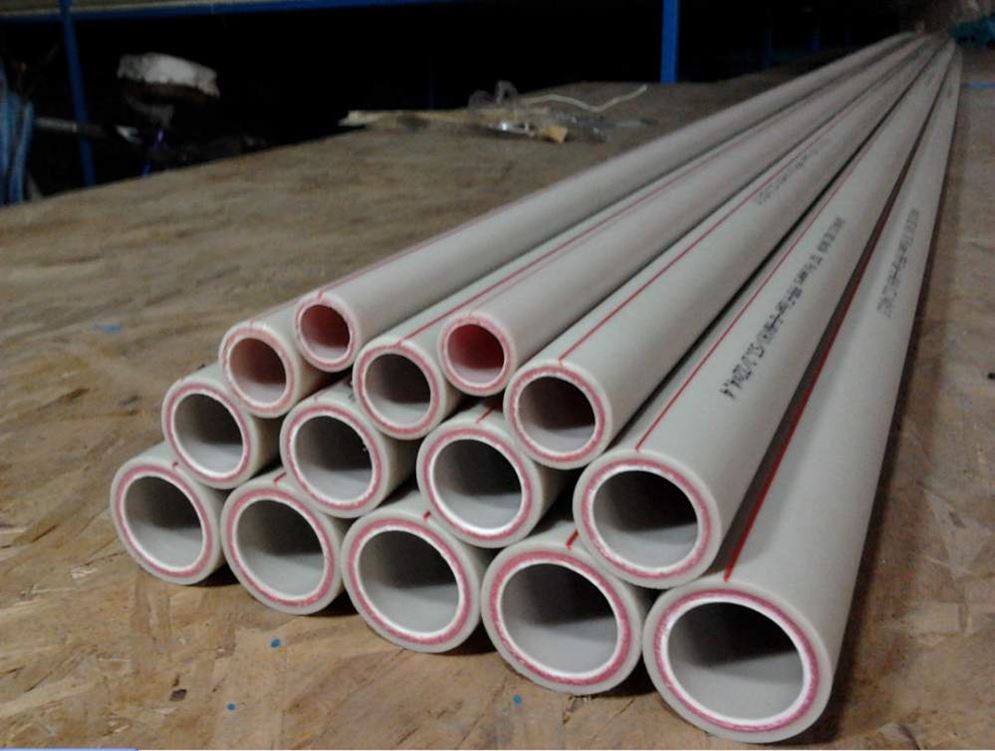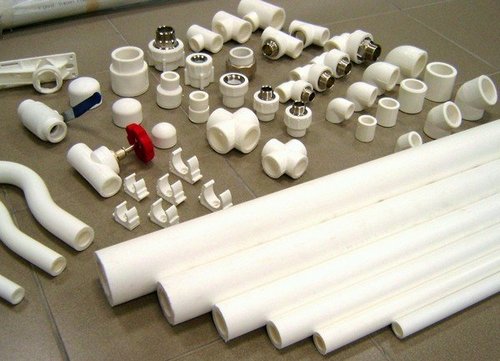Technical characteristics of polypropylene pipes for heating
Polypropylene pipes for heating
purpose
The main reason for this recommendation is that pipes made of steel and other metals have significantly lower strength values than reinforced polypropylene. This is due to the fact that significant salt deposits form on the inside of the products during the period of operation, which prevent the movement of liquid. Also an equally significant problem is internal rust.
The decrease in performance is due to the fact that temperature changes constantly occur in the heating system. Over time, the quality of products decreases and no longer meets the GOST standards.
There are several types of reinforced polypropylene pipes, which differ from each other.
It should be noted right away: polypropylene pipes that do not have reinforcement are of little use for a heating system. This is due to the fact that polypropylene in its original state does not withstand high temperatures.
When planning a heating system, it is strongly recommended to give preference to directly reinforced polypropylene pipes. The price of these products, unfortunately, is somewhat higher (by about 40%) than that of standard pipes, but the appearance and technical characteristics significantly compensate for this disadvantage.
In mounting the heating system, a significantly smaller number of expansion loops are used, so that it will not be necessary to use many welds, while the overall strength of the structure will be increased.
For the highest quality pipe fastening, fittings made of the same polypropylene with reinforcement are used.
It should be noted that polypropylene pipes that are not thick-walled cannot be used in hot water supply systems.
 The structure of the polypropylene pipe
The structure of the polypropylene pipe Advantages
Main advantages:
- the service life of the heating system increases depending on the strength of the welding joints;
- a strong plus is the coefficient of thermal conductivity, tending to minimal heat loss;
- installation of a system made of polypropylene has a significantly lower cost than from other materials.
 Heating system made of polypropylene
Heating system made of polypropylene disadvantages
Aluminum reinforced polypropylene pipes have several disadvantages. However, one of them is more pronounced than all the others: they need high-quality cleaning before welding.
Despite this disadvantage, some companies are actively using pipes with perforated aluminum reinforcement. Perforation has a rather strong effect on the level of oxygen penetration into the heating system. Due to such penetrations, the heating boiler and other parts of the heating system may fail.
Pipes with stripping, reinforced with fiberglass, do not have the above disadvantages.
Characteristics
Polypropylene pipes reinforced with fiberglass or aluminum can have an unlimited diameter, which is usually 16-63 mm, and this is not the limit.
It should be noted: one of the main technical aspects is based on the temperature resistance of the product. The maximum allowable temperature limit for polypropylene pipes is 95 degrees Celsius. In this case, the temperature can briefly rise to 110 degrees Celsius. These indicators make the product ideal for heating systems (in the case of a liquid heat carrier).
Fittings made of polypropylene allow you to fasten pipes without losing heat and strength.
The working pressure of reinforced polypropylene is 10, 16, 20 atmospheres (depending on the variety).
 Fittings made of polypropylene for fastening pipes
Fittings made of polypropylene for fastening pipes Extension
Polypropylene pipes have an important technical parameter - thermal expansion, which is strikingly different for reinforced and non-reinforced products.
The reinforced product has an identical, in comparison with metal-plastic pipes, expansion equal to 0.02 mm per 1 meter with a heating of 1 degree Celsius.
The expansion of an unreinforced product is 0.15 mm per meter at a temperature of 1 degree Celsius.
Working pressure is irrelevant.
Differences
The main difference between polypropylene pipes, dividing them into types, is the tolerance of temperature and pressure.
The cheapest are thin-walled pipes made of polypropylene with reinforcement. These products are designed for a maximum pressure of 10 atmospheres, they have a marking number PN-10.
As a rule, due to some “fragility”, these products are used exclusively in cold water supply systems. Fragility is expressed in the form of thin walls - 2.5-2.8 mm.
To mount the heating system, you need a diagram on which all the required dimensions of reinforced polypropylene pipes will be marked.
Among polypropylene pipes, not only PN-10, but also PN-16 are known. Unlike the previously mentioned, PN-16 are designed for a working pressure of 16 atmospheres. Their wall thickness reaches 3 mm, and the temperature limit is 80 degrees.
Polypropylene pipes PN-20 are even stronger. The thickness of their walls reaches 4 mm, the temperature limit is 85 degrees, and the maximum tolerated pressure reaches 20 atmospheres.
Choice
Before you finally decide on the choice of the right pipes, you need to know exactly how reinforcement occurs:
- the upper part of the pipe consists of a single sheet of aluminum, which is cut to a level of 1 mm during welding (in the case of perforated aluminum, the pipe walls are reinforced in the middle);
- composite material reinforcement consists of a mixture of solid polypropylene and fiberglass, which significantly affects the overall strength of the product;
- fiberglass reinforcement is made exactly in the middle of the pipe, while the surrounding walls consist of dense polypropylene.
Fittings are built in the same way as pipes.
Mounting
Having decided on the final choice, it is necessary to familiarize yourself with the subtle aspects of the installation of polypropylene, in particular with the rules of welding.
For heating, as mentioned earlier, pipes that can withstand a pressure of 25 atmospheres are ideal. Such products can also be used for hot water supply.
Heating system. Video
You can learn more about the house heating system from polypropylene pipes from the video below.
In conclusion, the main thing can be taken out - there are only three known types of polypropylene pipes:
- PN-10;
- PN-16;
- PN-20.
Each of them has the ability to contain a certain pressure and temperature.
Usually:
- PN-10 withstands pressure of 10 atmospheres at temperatures up to 80 degrees;
- PN-16 withstands pressure of 20 atmospheres at a temperature of 80 degrees;
- PN-20 can withstand pressure up to 20 atmospheres at a temperature of 85 degrees.
The final choice is up to the consumer.
In contact with
